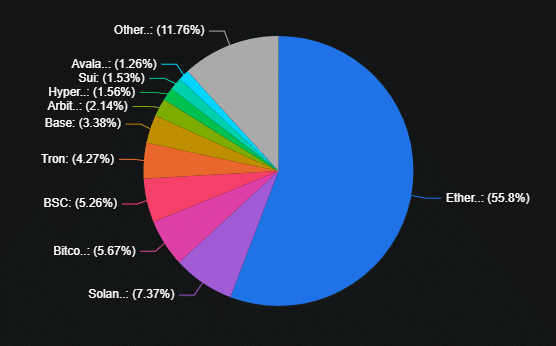-
DeFi lending platforms are increasingly favored over staking ETH, yet these innovative financial products fundamentally rely on the Ethereum network.
-
Despite declining staking rewards, Ethereum maintains robust network activity and dominance in decentralized finance (DeFi), underscoring its resilience and long-term potential.
-
According to COINOTAG analysis, the rise of yield-bearing stablecoins and DeFi protocols complements Ethereum’s ecosystem, driving adoption and enhancing overall value.
Ethereum staking rewards decline as DeFi lending and yield-bearing stablecoins offer higher returns, yet Ethereum remains the backbone of growing decentralized finance.
Ethereum Staking Rewards Decline Amid Growing Network Participation
Ethereum’s transition to Proof-of-Stake has seen a substantial increase in the amount of ETH locked for consensus participation, currently standing at approximately 34.9 million ETH, representing nearly 29% of the circulating supply. This surge in staking has naturally led to a decrease in individual staking rewards, which as of mid-June 2025, hover around 2.987% per annum. This decline is an intentional mechanism designed to balance network security with inflation control. While other blockchains like Solana, Polkadot, and Cosmos offer higher nominal staking yields, their elevated inflation rates—ranging from 4.5% to over 20%—dilute the real returns, positioning Ethereum’s lower inflation rate of 0.7% as a competitive advantage in preserving value.
Ethereum Price Stability Amid Volatility and Consolidation
Ethereum’s price has demonstrated resilience, fluctuating between $2,400 and $2,800 over recent weeks despite episodes of high intraday volatility reaching nearly 10%. Technical analysis highlights Ethereum’s ongoing consolidation phase, with the 50-week moving average acting as a significant resistance level. This price behavior reflects market participants’ cautious optimism, balancing short-term uncertainty with confidence in Ethereum’s long-term fundamentals.
Yield-Bearing Stablecoins and DeFi Lending Protocols Outperform ETH Staking
While traditional ETH staking rewards have diminished, alternative yield-generating opportunities within the Ethereum ecosystem have gained traction. Yield-bearing stablecoins such as Ethena’s staked USDe (SUSDE) offer attractive returns, currently yielding around 5.81% annually, with historical yields reaching up to 25%. These instruments enable investors to earn passive income on dollar-pegged assets, mitigating volatility risks inherent to cryptocurrencies.
DeFi Lending Platforms Drive Higher Returns and Network Growth
Leading DeFi lending protocols like Aave, MakerDAO (now Sky), and Compound facilitate liquidity pools where users can lend crypto assets and earn interest. At present, Aave’s staking rewards stand at approximately 4.63%, surpassing Ethereum’s staking yields. This competitive advantage attracts capital to DeFi platforms, enhancing liquidity and fostering broader ecosystem engagement. Importantly, these DeFi applications are built atop Ethereum, meaning their growth directly contributes to increased network usage and transaction fee revenue, reinforcing Ethereum’s position as the foundational layer of decentralized finance.

Source: DeFiLlama
Ethereum’s Dominance in DeFi Total Value Locked (TVL) Reinforces Its Ecosystem Strength
Ethereum continues to dominate the DeFi landscape, accounting for a commanding 55.8% share of the total value locked across all chains. This substantial market share underscores Ethereum’s role as the primary platform for decentralized applications and financial products. The thriving DeFi ecosystem not only provides diverse yield opportunities but also sustains demand for ETH, as network activity translates into transaction fees that benefit ETH holders and validators alike.
Implications for Investors and the Ethereum Network
Investors seeking passive income must weigh the trade-offs between staking ETH and engaging with DeFi lending or yield-bearing stablecoins. While staking offers network security participation and steady returns, DeFi products typically provide higher yields albeit with different risk profiles. Crucially, the growth of DeFi and stablecoin yields does not detract from Ethereum’s value proposition; rather, it enhances network utility and adoption, which are vital for long-term appreciation of ETH.
Conclusion
Ethereum’s staking rewards have declined as more ETH is locked in the network, reflecting a healthy and secure Proof-of-Stake environment. Meanwhile, yield-bearing stablecoins and DeFi lending protocols offer higher returns, attracting capital and expanding Ethereum’s ecosystem. Far from losing ground, Ethereum remains the backbone of decentralized finance, with its robust network activity and dominant TVL share positioning it for sustained growth. Investors should consider the complementary nature of staking and DeFi yields when strategizing their crypto portfolios, recognizing that increased DeFi adoption ultimately strengthens Ethereum’s long-term value.






